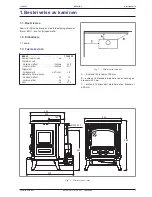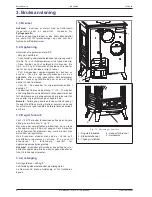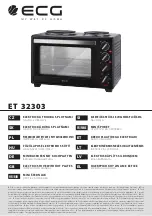
clockwise.
- if the flame is too high, reduce the flame by turning the
setting screw (# 2) counter clockwise.
High setting (Refer to # 3, fig. 12) :
- set the regulating knob on “6" and let the burner run
for a few minutes. The flame must be shaped like a cone
and reach the upper part of the door.
- if the flame is too low, increase the flame by turning the
setting screw counter clock wise.
- if the flame is too high, reduce the flame by turning the
setting screw clockwise.
Please note - Very important : The adjustments of the
float regulator are very sensitive. The high and the low
setting screws must never be turned more than a 1/4 of
a turn at a time in any direction from their initial setting.
When making any adjustments, allow 3 to 5 minutes
between adjustments to allow burner to stabilize to
previous adjustment before proceeding, if necessary.
2.11. Chimney draught
Once the stove has been properly installed, the
chimney draught must be checked.
The adjustment of the draught will be made with the
barometric damper located at the back of the stove
(# 1, fig. 12).
The reading of the draught must be done once the unit
is hot (minimum 30 minutes of use).
Refer to the specifications p. 3 for minimum draught
requirement on low setting and on high setting.
2.12. Door closing pressure
The closing latch rotates around a pressure screw
positioned cam (fig. 13).
- Loosen pressure screw 1.
- Turn cam to desired position 2.
- Tighten pressure screw 1.
2.13. Maintenance of the Chimney
Chimney and chimney connector should be inspected
at least once every three months during the heating
season to determine if a soot build up has occurred. If
soot has accumulated, it should be removed to reduce
the risk of a chimney fire.
1
2
Figure 13 - Door closing pressure
1 - Pressure screw
2 - Cam
Document n° 979-3 EN ~ 28/02/2000
Oil fired stove
BELFORT
174 05 05
Technical manual
7








































